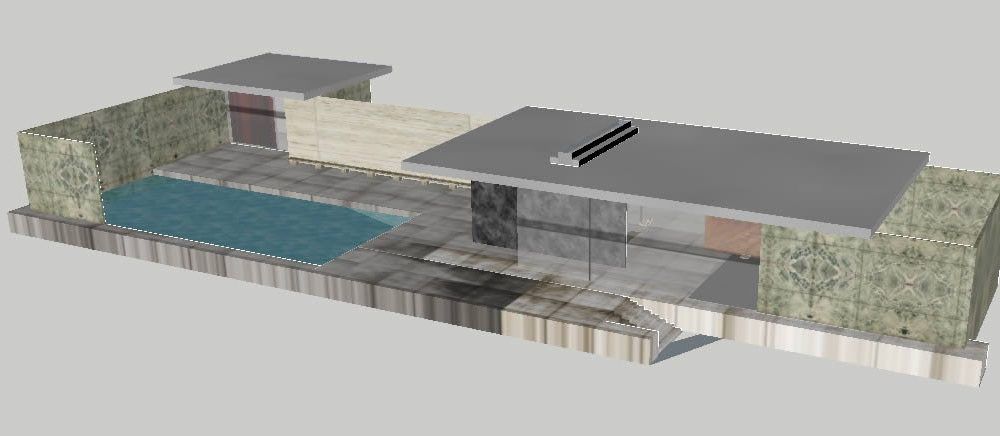


You then choose from dozens of different types of fences or walls. Simply draw lines and edges, combine them into a group and activate the scripts. The two listed scripts below automate the creation of complex fences, gates, retaining walls and more. These low cost extensions can save you many hours of modeling. He has two new scripts that are a must have. He previously brought us Instant Road, Instant Roof and Instant Grade.
#ELEV45 PLUGIN SKETCHUP SERIES#
(7) and (8) Vali Architecture Series – Instant Fence and Instant WallĬhuck Vali, an architect by practice, programs SketchUp extensions for “beer money” (as he says it), and has created powerful and must have plugins.

The result (bottom image) is a curving sloping wall and ramp. The ramp and wall can be bent with the Shape Bender extension to match the arc. Select the terrain mesh (not the group but all the loose faces), select two colors and the extension will color the surfaces based on their height, displaying surfaces with a gradient of color from highest to lowest.ĬLF Tools Color By Z shows elevation colors from green (low) to red (high). The extension colored surfaces ranging from yellow (flat) to blue (steep), displaying a color gradient showing the range of flat to steep surfaces.Ĭolor By Z will color selected faces and even better, terrain, based on elevation. While it won’t color slopes based on specific grade values, it’s a quick and easy way to view terrain grades for fast studies.ĬLF Color by Slope: Yellow and blue were the selected colors for the slopes map. Select your surfaces (best suited for a terrain model), input two color values and this extension will color the selected faces based on their slope. It is a must have script if you are modeling site plans with vegetation.Ĭolor By Slope is a SketchUp slope analysis tool. It’s IDEAL for randomizing vegetation size and positions. Scale and Rotate Multiple, among other things, allows you to randomize the scale and rotation of selected objects and components. This excellent tool replaces the Ruby Script Randor. THANK YOU CHRIS!!!Ĭhris Fulmer, a landscape architect, has many excellent tools on the SketchUp Extension Warehouse. Simply search for Chris Fulmer in the Extension Warehouse or look for CLF TOOLS. Below are some of the tools he has developed that are worth installing and trying out.Įven better, many of these tools can be found in the SketchUp Extension Warehouse. Aside from the great news of a landscape architect working on SketchUp, Chris has many extensions that are just awesome. Recently, Trimble SketchUp hired Chris as part of the quality assurance and development team. He has been a long time SketchUp user and has developed many extensions for use in SketchUp. (3-6) Chris Fulmer SketchUp Extensions: CLF TOOLSĬhris Fulmer is a landscape architect and programmer. SketchUcation Plugin Store Extension and associated menus in SketchUp. You can find the SketchUcation Plugin Store here:
#ELEV45 PLUGIN SKETCHUP FOR FREE#
Just register for free with SketchUcation, download the plugin and start installing plugins. The SketchUcation Plugin Store and all the extensions are all free. Between SketchUp’s Extension Warehouse and the SketchUcation Plugin Store, you should be able to find all the custom SketchUp tools you need.
#ELEV45 PLUGIN SKETCHUP INSTALL#
You can install and manage all your extensions with this plugin. Called the SketchUcation Plugin Store, it allows you to browse over 600 (yes 600!) SketchUp extensions. Not to be outdone, SketchUcation, the popular SketchUp user forum (has released its own version of the extension warehouse. SketchUp 2013 and SketchUp Make (free version) include the Extension Warehouse which functions inside the program. The Extension Warehouse allows users to search, install and manage extensions directly from a menu inside SketchUp. Much like SketchUp’s 3D Warehouse (where you can search and download models), the Extension Warehouse provides quick and easy access to custom tools. The Extension Warehouse changes all that. For many SketchUp users this could be confusing if not difficult. In previous SketchUp versions (like SU 8), you needed to manually install extensions usually by browsing to the root SketchUp program folder on your hard drive. You will need to login with a Google account and then you can access all the extensions. SketchUp 2013, the recent release from Trimble SketchUp, includes the Extension Warehouse (Window Extension Warehouse). That will insure the extensions will work for you. These can be found at the point of download.

It is suggested that you read any of the instructions or watch the videos that accompany the extensions below before using them.


 0 kommentar(er)
0 kommentar(er)
